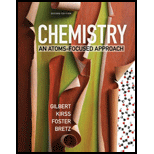
To determine:
The molality of each of the given solutions from given molarity and density
Answer to Problem 11.59QA
Solution:
a. Molality of CaCl2 = 1.34 m
b. Molality of fructose = 2.61 m
c. Molality of ethylene glycol = 17.4 m
d. Molality of LiCl = 2.05 m
Explanation of Solution
1. Formulae:
i. Molality of the solution is moles of solute divided by the mass of solvent in kg.
ii. Molarity of the solution is moles of solute divide by volume of solution in liter.
iii. Density of solution is mass divided by volume of solution
iv. Mass of the solution is mass of solvent and mass of solute
To calculate the molality of the solution, we need to calculate the moles of solute and mass of solvent in kg from the density and molarity.
A mole is the SI unit of amount chemical substance. When writing units, it is written as “mol”.
a. Molality of CaCl2
2. Given
i.
ii. Density (d)
3. Calculations
To calculate the moles of CaCl2 from
So, moles of solute
The mass of CaCl2 is
The density of the solution in g/L is
So,
We know the mass of CaCl2 and mass of solution; we can calculate the mass of solvent.
The molality of the CaCl2 solution from the moles and mass of solvent is
The molality of
b. Molality of fructose
2. Given
i.
ii. Density (d)
3. Calculations
To calculate the moles of C6H12O6 from
So, moles of solute
The mass of C6H12O6 is
The density of the solution in g/L is
So, 1 L of the solution contains 1139 g of solution.
We know the mass of solute C6H12O6 and mass of solution; we can calculate the mass of solvent.
The molality of the C6H12O6 solution from the moles and mass of solvent is
The molality of the
c. Molality of Ethylene glycol
2. Given
i.
ii. Density (d)
3. Calculations
To calculate the moles of ethylene glycol from
So, moles of solute
The mass of ethylene glycol is
The density of the solution in g/L is
So, 1 L of the solution contains 1069 g of solution.
We know the mass of ethylene glycol and mass of solution; we can calculate the mass of solvent.
The molality of the ethylene glycol solution from the moles and mass of solvent is
The molality of the
d. Molality of LiCl
2. Given
i.
ii. Density (d)
3. Calculations
To calculate the moles of LiCl from
So, moles of solute
The mass of LiCl is
The density of the solution in g/L is
So,
We know the mass of LiCl and mass of solution; we can calculate the mass of solvent.
The molality of the LiCl solution from the moles and mass of solvent is
The molality of
Conclusion:
Molality of the solution has been calculated from the molarity and density of the solution.
Want to see more full solutions like this?
Chapter 11 Solutions
CHEM:ATOM FOC 2E CL (TEXT)
- Draw a tetramer of this alternating copolymer.arrow_forwardH I T H HH H -H C. H- Identify and select all structures below that represent a constitutional isomer(s) of the compound shown above. H- H CIH H H H HHHH H H 0 ·H H– 冊 CH CHI HH C- H- H H- H H A. H H C H H- -H HH H B. H- -H D. H H H H • H -H E. -H H H HICH T HHH F. H-arrow_forwardPolylactic acid (shown below) is a biodegradable polymer used for food packaging. Identify the monomer(s) used in the production of this polymer using a condensation process.arrow_forward
- Draw the product of the reaction shown below. Ignore small byproducts that would evaporate pleasearrow_forwardPoly(ethylene adipate) is a biodegradable polyester (shown below). Identify the type of polymerization process used in the production of this polymer.arrow_forwardPolymers may be composed of thousands of monomers. draw two repeat units(dimer) of the polymer formed in this reaction. assume there are hydrogen atoms on the two ends of the dimer. ignore inorganic byproducts pleasearrow_forward
- Draw the product of the reaction shown below. Use a dash or wedge bond to indicate stereochemistry of substituents on asymmetric centers, Ignore inorganic byproductsarrow_forwardDraw the product of this reaction please. Ignore inorganic byproductsarrow_forwardOne of the pi molecular orbitals of 1,3-butadiene (CH2=CHCH=CH2) is shown below. Please identify the number of nodal planes perpendicular to the bonding axisarrow_forward
- Draw the monomers required to synthesize this condensation polymer please.arrow_forwardProvide the correct systematic name for the compound shown here. Please take into account the keyboard options belowarrow_forwardcurved arrows are used to illustrate the flow of electrons. using the provided starting and product structures, draw the curved electron-pushing arrows for the following reaction or mechanistic step(s)arrow_forward
 ChemistryChemistryISBN:9781305957404Author:Steven S. Zumdahl, Susan A. Zumdahl, Donald J. DeCostePublisher:Cengage Learning
ChemistryChemistryISBN:9781305957404Author:Steven S. Zumdahl, Susan A. Zumdahl, Donald J. DeCostePublisher:Cengage Learning ChemistryChemistryISBN:9781259911156Author:Raymond Chang Dr., Jason Overby ProfessorPublisher:McGraw-Hill Education
ChemistryChemistryISBN:9781259911156Author:Raymond Chang Dr., Jason Overby ProfessorPublisher:McGraw-Hill Education Principles of Instrumental AnalysisChemistryISBN:9781305577213Author:Douglas A. Skoog, F. James Holler, Stanley R. CrouchPublisher:Cengage Learning
Principles of Instrumental AnalysisChemistryISBN:9781305577213Author:Douglas A. Skoog, F. James Holler, Stanley R. CrouchPublisher:Cengage Learning Organic ChemistryChemistryISBN:9780078021558Author:Janice Gorzynski Smith Dr.Publisher:McGraw-Hill Education
Organic ChemistryChemistryISBN:9780078021558Author:Janice Gorzynski Smith Dr.Publisher:McGraw-Hill Education Chemistry: Principles and ReactionsChemistryISBN:9781305079373Author:William L. Masterton, Cecile N. HurleyPublisher:Cengage Learning
Chemistry: Principles and ReactionsChemistryISBN:9781305079373Author:William L. Masterton, Cecile N. HurleyPublisher:Cengage Learning Elementary Principles of Chemical Processes, Bind...ChemistryISBN:9781118431221Author:Richard M. Felder, Ronald W. Rousseau, Lisa G. BullardPublisher:WILEY
Elementary Principles of Chemical Processes, Bind...ChemistryISBN:9781118431221Author:Richard M. Felder, Ronald W. Rousseau, Lisa G. BullardPublisher:WILEY





